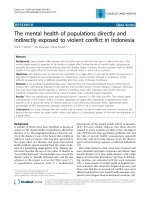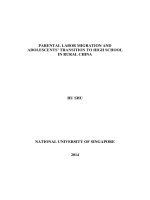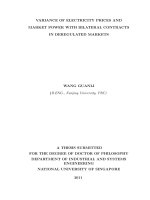Misfortunes of War - Press and Public Reactions to Civilian Deaths in Wartime docx
Bạn đang xem bản rút gọn của tài liệu. Xem và tải ngay bản đầy đủ của tài liệu tại đây (1.65 MB, 299 trang )
This document and trademark(s) contained herein are protected by law
as indicated in a notice appearing later in this work. This electronic
representation of RAND intellectual property is provided for non-
commercial use only. Permission is required from RAND to reproduce, or
reuse in another form, any of our research documents.
Limited Electronic Distribution Rights
Visit RAND at www.rand.org
Explore RAND Project AIR FORCE
View document details
For More Information
This PDF document was made available
from www.rand.org as a public service of
the RAND Corporation.
6
Jump down to document
THE ARTS
CHILD POLICY
CIVIL JUSTICE
EDUCATION
ENERGY AND ENVIRONMENT
HEALTH AND HEALTH CARE
INTERNATIONAL AFFAIRS
NATIONAL SECURITY
POPULATION AND AGING
PUBLIC SAFETY
SCIENCE AND TECHNOLOGY
SUBSTANCE ABUSE
TERRORISM AND
HOMELAND SECURITY
TRANSPORTATION AND
INFRASTRUCTURE
WORKFORCE AND WORKPLACE
The RAND Corporation is a nonprofit
research organization providing
objective analysis and effective
solutions that address the challenges
facing the public and private sectors
around the world.
Purchase this document
Browse Books & Publications
Make a charitable contribution
Support RAND
This product is part of the RAND Corporation monograph series.
RAND monographs present major research findings that address the
challenges facing the public and private sectors. All RAND mono-
graphs undergo rigorous peer review to ensure high standards for
research quality and objectivity.
Prepared for the United States Air Force
Approved for public release; distribution unlimited
Eric V. Larson • Bogdan Savych
MISFORTUNES
OF WAR
Press and Public
Reactions
to Civilian Deaths
in Wartime
The RAND Corporation is a nonprofit research organization providing
objective analysis and effective solutions that address the challenges
facing the public and private sectors around the world. RAND’s
publications do not necessarily reflect the opinions of its research clients
and sponsors.
R
®
is a registered trademark.
© Copyright 2006 RAND Corporation
All rights reserved. No part of this book may be reproduced in any
form by any electronic or mechanical means (including photocopying,
recording, or information storage and retrieval) without permission in
writing from RAND.
Published 2006 by the RAND Corporation
1776 Main Street, P.O. Box 2138, Santa Monica, CA 90407-2138
1200 South Hayes Street, Arlington, VA 22202-5050
4570 Fifth Avenue, Suite 600, Pittsburgh, PA 15213-2665
RAND URL: />To order RAND documents or to obtain additional information, contact
Distribution Services: Telephone: (310) 451-7002;
Fax: (310) 451-6915; Email:
The research reported here was sponsored by the United States Air
Force under Contract F49642-01-C-0003. Further information may be
obtained from the Strategic Planning Division, Directorate of Plans, Hq
USAF.
Library of Congress Cataloging-in-Publication Data
Larson, Eric V. (Eric Victor), 1957–
Misfortunes of war : press and public reactions to civilian deaths in wartime /
Eric V. Larson, Bogdan Savych.
p. cm.
“Aerospace Force Development Program of RAND Project AIR FORCE.”
Includes bibliographical references.
ISBN-13: 978-0-8330-3897-5 (pbk.)
1. Civilian war casualties. 2. Mass media and war. 3. War in mass media. 4.
United States. Air Force—History—20th century. 5. United States. Air Force—
History—21st century. 6. United States. Air Force—Public relations. 7. Combatants
and noncombatants (International law) 8. Military history, Modern—20th century.
9. Military history, Modern—21st century. 10. War—Moral and ethical aspects.
I. Savych, Bogdan. II. Project Air Force (U.S.) III. Rand Corporation. IV. Title.
U21.2.L375 2006
363.34'98—dc22
2006030856
iii
Preface
Concern in U.S. military and policymaking circles about civilian casu-
alties and collateral damage in U.S. military operations appears to have
increased since the end of the Cold War. In part, this concern appears
to be based upon beliefs about the reactions of U.S. and foreign press
and publics in response to these incidents, especially the belief that
incidents of civilian deaths reduce public support for military opera-
tions. ere has not, however, been any sort of empirical analysis of
press and public reactions to these incidents or of the effect of these
incidents on public support.
To improve policymakers’ and senior military leaders’ understand-
ing of this topic, this monograph provides the results of a mixed quan-
titative and qualitative analysis of U.S. and foreign media and public
opinion reactions to incidents of collateral damage involving civilian
deaths in recent U.S. wars and military operations. It is part of a larger
RAND Project AIR FORCE fiscal year 2004 study titled “Controlling
Collateral Damage in Air Operations.” e research reported here was
sponsored by Maj Gen Teresa M. Peterson (AF/XOO) and conducted
within the Aerospace Force Development Program of RAND Project
AIR FORCE.
RAND Project AIR FORCE
RAND Project AIR FORCE (PAF), a division of the RAND Corpo-
ration, is the U.S. Air Force’s federally funded research and develop-
ment center for studies and analyses. PAF provides the Air Force with
iv Misfortunes of War: Press and Public Reactions to Civilian Deaths in Wartime
independent analyses of policy alternatives affecting the development,
employment, combat readiness, and support of current and future aero-
space forces. Research is conducted in four programs: Aerospace Force
Development; Manpower, Personnel, and Training; Resource Manage-
ment; and Strategy and Doctrine.
Additional information about PAF is available at our Web site at
/>Contents
v
Preface iii
Figures
ix
Tables
xiii
Summary
xvii
Acknowledgments
xxv
Abbreviations
xxvii
CHAPTER ONE
Introduction 1
Literature Review
4
John E. Mueller
5
e Principal Policy Objective (PPO) Approach
6
Eric Larson
9
Peter D. Feaver and Christopher Gelpi
11
Scott S. Gartner and Gary M. Segura
13
Approach
15
Organization of is Monograph
18
CHAPTER TWO
Operation Desert Storm (Iraq, 1991) 21
Civilian Casualty Estimates
21
Handling of the Civilian Casualties Issue
24
e Arc of Media and Public Concern
26
U.S. Media and Public Opinion Responses
26
Foreign Media and Public Opinion
35
vi Misfortunes of War: Press and Public Reactions to Civilian Deaths in Wartime
e Al Firdos Bunker Incident 43
U.S. Media and Public Opinion Responses
45
Foreign Media and Public Opinion Responses
57
Key Lessons
58
CHAPTER THREE
Operation Allied Force (Kosovo, 1999) 63
Civilian Casualty Estimates
64
Estimates of Civilian Deaths Due to NATO Action
64
Civilian Deaths Due to FRY Action
67
Estimates of FRY Military Deaths Due to NATO Action
71
Handling of the Civilian Casualties Issue
71
e FRY’s Handling of the Casualties Issue
71
e U.S. Coalition’s Treatment of the Civilian Casualties Issue
74
e Arc of Media and Public Concern
75
U.S. Media and Public Opinion Responses
75
Foreign Media and Public Opinion
85
e April 14 Convoy Attacks Outside Djakovica
92
U.S. Media and Public Opinion Responses
99
Foreign Media and Public Opinion Responses
104
e May 7 Chinese Embassy Bombing
106
U.S. Media and Public Opinion Responses
109
Foreign Media and Public Opinion Responses
115
Conclusions
119
CHAPTER FOUR
Operation Enduring Freedom (Afghanistan, 2001–) 125
Civilian Casualty Estimates
125
Handling of the Civilian Casualties Issue
127
e Arc of Media and Public Concern
129
U.S. Media and Public Opinion Responses
129
Foreign Media and Public Opinion
140
e Wedding Party Incident
150
Background on the Incident
150
U.S. Media and Public Opinion Responses
152
Foreign Media and Public Opinion Responses 155
Key Lessons
156
CHAPTER FIVE
Operation Iraqi Freedom (Iraq, 2003–) 159
Civilian Casualty Estimates
159
Handling of the Civilian Casualties Issue
161
e Arc of Media and Public Concern
163
U.S. Media and Public Opinion
163
Foreign Media and Public Opinion
186
e Marketplace Incident
191
Background on the Incident
191
U.S. Media and Public Opinion Responses
192
Foreign Media and Public Opinion Responses
197
Key Lessons
202
CHAPTER SIX
Implications and Conclusions 205
e Military: A Highly Credible Institution
208
Recommendations
215
APPENDIX
Multivariate Statistical Modeling Results 217
Bibliography
235
Contents vii
Figures
ix
1.1. U.S. Major Television and Newspaper Reporting on
Civilian Casualties, 1990–2003
2
1.2. Selected Foreign Media Reporting on Civilian Casualties,
1990–2003
3
2.1. Monthly Major Television and Newspaper Reporting on
Iraq, August 1990–June 1991
27
2.2. Major U.S. Television and Newspaper Weekly Reporting
on Iraq During the Gulf War
27
2.3. Selected Foreign Media Reporting on Iraq,
August 1990–June 1991
35
2.4. Selected Foreign Media Weekly Reporting on Iraq,
January–February 1991
36
2.5. Europeans’ Approval of the Decision to Use Military
Force Against Iraq, March 1991
39
2.6. U.S. Media Reporting on Civilian Casualties in Iraq
During the Gulf War
46
2.7. Key Terms and Phrases Used During the Gulf War
48
2.8. Confidence at Al Firdos Bunker Was a Legitimate
Military Target
53
2.9. Views on Whether the United States Was Making
Enough Effort to Avoid Bombing Civilian Areas Before
and After Al Firdos Incident
54
2.10. Selected Foreign Reporting on Civilian Casualties,
February 7–21, 1991
58
3.1. Major News Reporting on Kosovo, January–July 1999
76
3.2. Number of Television News Stories by War Topic
77
3.3. CNN Daily Reporting on Civilian Casualties and
Collateral Damage
78
x Misfortunes of War: Press and Public Reactions to Civilian Deaths in Wartime
3.4. How Closely Was the Public Following Kosovo? 79
3.5. Americans’ Concern About Various Costs in Kosovo,
March–May 1999
80
3.6. Selected Foreign Media Reporting on Kosovo,
January–December 1999
85
3.7. Polling on Kosovo by ICM for e Guardian Newspaper,
March–April 1999
90
3.8. French Support for Participation in NATO Intervention,
Late March–Mid-May 1999
91
3.9. U.S. Reporting on Civilian Casualties, Convoy Incident
100
3.10. Selected Foreign Media Reporting on Civilian Casualties,
Convoy Incident
105
3.11. Media Reporting on Civilian Casualties,
Chinese Embassy Incident
109
3.12. Reporting on Chinese Embassy Incident in 53 Major
Newspapers
110
3.13. Focus of News Reports Before and After Chinese
Embassy Incident
111
3.14. TV News Evaluations of U.S. Policy Before and After
Chinese Embassy Incident
112
3.15. Foreign Media Reporting on Civilian Casualties,
Chinese Embassy Incident
117
4.1. Major U.S. Newspaper and Television Reporting on
Afghanistan, August 2001–March 2004
129
4.2. Major U.S. Newspaper Reporting on Afghanistan and
Civilian Casualties, August 2001–March 2004
130
4.3. Americans’ Attention to Afghanistan,
October 2001–July 2002
131
4.4. Support for Military Action in Afghanistan Even if
Civilian Casualties, Mid-September 2001
132
4.5. Support for Military Action in Afghanistan Even if
Civilian Casualties, Late September 2001
134
4.6. Selected Foreign Media Reporting on Afghanistan,
August 2001–March 2004
140
4.7. Should the United States Attack Military and Civilian
Targets? Mid-September 2001
141
4.8. Support for U.S. Military Action, Mid-September 2001
143
4.9. Approval of Own Country’s Military Participating in
U.S. Military Action, September 2001
144
4.10. Support for U.S. Air War in Afghanistan in 20 Countries,
November–December 2001
145
4.11. Rating of Bush Administration Handling of the War in
Afghanistan in the United States and Six European
Countries, June–July 2002
146
4.12. Support for U.S Led War on Terrorism in 43 Countries,
July–October 2002
147
4.13. Reporting on Civilian Casualties in Afghanistan in
Major Papers and on Television
153
4.14. Selected Foreign Media Reporting on Civilian Casualties
in Afghanistan, Wedding Party Incident
156
5.1. U.S. Major Television and Major Reporting on Iraq,
August 2002–March 2004
163
5.2. Weekly Major News Reporting on Iraq,
March–June 2003
164
5.3. Major U.S. Media Reporting on Iraq and Civilian
Casualties, August 2002–March 2004
165
5.4. Percentage of Television News Stories by Subject,
March 19–April 14, 2003
166
5.5. Attention to Iraq, August 2002–March 2004
168
5.6. Adequacy of Press Attention to Civilian Casualties and
Other Iraq Issues
169
5.7. Preferred Priority for Minimizing Civilian Casualties
and Other Desiderata, Early April 2003
173
5.8. Belief at War Would Be a Success Given
Hypothesized Civilian Casualties, Early April 2003
183
5.9. Reporting on Antiwar Demonstrations in Major
U.S. Media, August 2002–March 2004
186
5.10. Selected Foreign Media Reporting on Iraq,
August 2002–March 2004
187
5.11. Selected Foreign Media Reporting on Iraq,
August 2002–March 2004
188
5.12. Mentions of Iraq and Civilian Casualties in Selected
Foreign Media by Period
189
5.13. High-Altitude Diagram Used by MG McChrystal
193
5.14. Reporting on Civilian Casualties, Marketplace Incident
194
5.15. Daily Foreign Reporting on Civilian Casualties in Iraq,
Marketplace Incident, March 19–April 2
198
Figures xi
xii Misfortunes of War: Press and Public Reactions to Civilian Deaths in Wartime
5.16. Belief in 20 Countries at United States Tried Very
Hard to Avoid Civilian Casualties in Iraq,
April–May 2003
199
5.17. Does the United States Do Enough to Avoid (Civilian)
Casualties? Results from 11 Countries
200
5.18. Iraqi Beliefs About How Hard the United States Is
Trying to Avoid Casualties, Spring 2004
201
6.1. Annual Mentions of Civilian Casualties by Opinion
Leaders, 1990–2003
206
6.2. Major U.S. Media Reporting on War and Selected
NGOs, 1990–2003
206
6.3. Annual Mentions of Antiwar Demonstrations in
U.S. Major Media Reporting, 1990–2003
207
6.4. Percent Saying ey Have a “Great Deal” or
“Quite a Lot” of Confidence in Military, 1971–2005
210
6.5. Americans’ Confidence in Institutions, June 2003
212
Tables
xiii
1.1. Importance to Americans of Civilian Deaths in Using the
American Military
4
2.1. How Closely Did Americans Follow Developments in the
Gulf?
29
2.2. Approval of the Campaign by Expected Military and
Civilian Casualties, February 15–17, 1991
30
2.3. Postincident Timeline for Al Firdos Incident
44
2.4. Views on Avoiding Bombing Civilian Areas Before and
After Al Firdos Incident
52
2.5. Approval and Disapproval of Going to War with Iraq
Before and After Al Firdos Bombing
55
2.6. Views on Whether U.S. Forces Were Inflicting Excessive
Damage, February 12–13, 1991
55
2.7. Approval of the War in Iraq, January–February 1991
56
3.1. Comparison of Support for Air War and Ground Options
72
3.2. Knowledge or Estimates of Civilian Casualties in Kosovo
81
3.3. Cross-Tabulation of the Approval of the Campaign in
Kosovo and Beliefs About Effort of the United States in
Avoiding Civilian Casualties, April 1999
83
3.4. Cross-Tabulation of the Approval of the Campaign in
Kosovo and Beliefs About Effort of the United States in
Avoiding Civilian Casualties, May 1999
84
3.5. U.S. and European Opinion on the War,
March–April 1999
86
3.6. Support for War in Kosovo in 16 Countries,
March–April 1999
87
3.7. Support for European Defense Independent of NATO,
March–April 1999
88
xiv Misfortunes of War: Press and Public Reactions to Civilian Deaths in Wartime
3.8. European Support for the War in Kosovo in
Early April 1999
89
3.9. European and U.S. Support for the War in Kosovo in
Late April 1999
89
3.10. Postincident Timeline for Djakovica Convoy Incident
95
3.11. Attention Paid to Kosovo Before, During,
and After Convoy Incident
100
3.12. Approval of War Before and After the Convoy Incident
101
3.13. Which Kosovo Pictures and Stories Most Caught
Respondents’ Attention? April 1999
102
3.14. Cross-Tabulation of Approval and Concern About Serb
Civilians Being Hurt or Killed
103
3.15. Are We Being Careful Enough to Avoid Civilian
Casualties? By Party, April 1999
104
3.16. European and Support for the War in Kosovo in
Late April 1999
106
3.17. Postincident Timeline for Chinese Embassy Incident
107
3.18. Attention Paid to Kosovo Before and After May 7
Chinese Embassy Incident
113
3.19. Approval and Beliefs About Aggressiveness of War
by Day, May 7–9, 1999
114
3.20. Approval of the War Before and After the May 7
Chinese Embassy Incident
115
3.21. European Support for the War in Kosovo
in Mid-May 1999
118
3.22. Americans’ Concern About Civilian Casualties,
April–May 1999
121
3.23. Comparison of Beliefs About Coalition Efforts to Avoid
Casualties, Post–Convoy Incident and Post–Chinese
Embassy Incident
122
4.1. AP Estimate of Civilian Casualties, February 2002
127
4.2. Judgments About Effectiveness of Military Strikes if
Civilian Casualties
133
4.3. Approval of Military Action if Civilian Casualties
Would Result
135
4.4. United States Doing All It Reasonably Can to Avoid
Casualties?
136
4.5. Greater Concern About Civilian Casualties or
Achieving Victory?
136
4.6. Accuracy of Information Government Is Providing
About Civilian Casualties
137
4.7. Approval of Military Action if Civilian Casualties
Would Result
138
4.8. Number of Foreign Publics Polled and Number Where
Majority Supported United States
148
4.9. Differences in Support, November–December 2001 and
July–October 2002 Polls
149
4.10. Postincident Timeline for Wedding Party Incident
152
4.11. Attention Paid to Afghanistan Before and After
July 1 Incident
154
4.12. Approval Before and After the July 1
Wedding Party Incident
155
5.1. Assessment of Press Coverage of Civilian Casualties
in Iraq, Early April 2003
168
5.2. Greatest Worries About War in Iraq, March 2003
170
5.3. Concern About Iraqi Civilians Being Killed,
2002 and 2003
171
5.4. Concern About Iraqi Civilians Being Killed, 1991
172
5.5. Greatest Worries About U.S. Uses of Military Force,
November 2001 and March 2003
172
5.6. Should the United States Strike Targets Even in
Civilian Areas in Iraq? March 2003
174
5.7. Assessment of U.S. Efforts to Minimize Civilian
Casualties in Iraq, March 2003
174
5.8. Willingness to Bomb Baghdad in Two Wars,
1991 and 2003
175
5.9. Assessment of U.S. Efforts to Minimize Civilian
Casualties in Iraq, March 2003
176
5.10. Support for More Aggressive Action Even if Civilian
Casualties in Iraq, August 2003
176
5.11. Assessment of U.S. Efforts to Minimize Civilian
Casualties, Late March–Early April
177
5.12. Assessment of U.S. Efforts to Minimize Civilian
Casualties in Iraq, March 2003
178
5.13. Assessment of U.S. Efforts to Minimize Civilian
Casualties in Iraq, Late March–Early April 2003
179
5.14. Assessment of U.S. Efforts to Minimize Civilian
Casualties in Iraq, Early April 2003
179
Tables xv
xvi Misfortunes of War: Press and Public Reactions to Civilian Deaths in Wartime
5.15. Civilian Casualties in Iraq and Expectations,
Early April 2003
180
5.16. Assessment of U.S. Efforts to Minimize Civilian
Casualties in Iraq, April–December 2003
181
5.17. War in Iraq Successful if Civilian Casualties?
Early April 2003
182
5.18. Postincident Timeline for March 26, 2003,
Marketplace Incident
191
5.19. Approval Before and After March 26
Marketplace Incident
195
5.20. Fatigue Before and After March 26 Marketplace Incident
196
5.21. Confidence in U.S. Military and Press Before and After
March 26 Marketplace Incident
196
6.1. Credibility Scores of Various Sources from National
Credibility Index
213
A.1. Reduced-Form Coefficients from Probit Estimates of
Approval of Gulf War, February 15–17, 1991
222
A.2. Coefficients from the Probit Estimates (Reduced Form)
for Beliefs About the Worth of the Campaign in Iraq,
February 1991
223
A.3. Wording of Questions in Tables A.1 and A.2
224
A.4. Coefficients from Probit Estimates for Approval (Q13) of
Kosovo Campaign, May 1999
225
A.5. Wording of Questions in Table A.4
227
A.6. Marginal Probability from the Probit Estimates of
Approval of Operations in Afghanistan (Q2)
229
A.7. Wording of Questions in Table A.6
229
A.8. Coefficients from the Probit Estimates for Approval (Q3)
of the Military Campaign in Iraq, March 2003
230
A.9. Wording of Questions in Table A.8
231
A.10. Coefficients from Probit Estimates for Support of the
Military Campaign in Iraq, April 2003
232
A.11. Wording of Questions in Table A.10
233
xvii
Summary
Although the number of armed conflicts worldwide has declined since
the spasm of violence that followed the breakup of the Soviet Union
and the Balkans, war has continued to wreak havoc, albeit in a dimin-
ishing number of locations. Western nations, such as the United States,
have, through the development of international law, military strategy,
doctrine, tactics, technologies, and procedures, sought to alleviate some
of the burdens that war imposes on innocents.
Nevertheless, U.S. adversaries have just as creatively found ways
to place innocents at risk and thereby increase the human and moral
costs of the nation’s wars, evidently in the hope of deterring the United
States from taking military action in the first place or of imposing
political costs and constraints on the conduct of military operations if
their deterrent efforts fail.
Judging both by their statements and the evident energy they
expend on the matter, national political and military leaders appear
to attach a great deal of importance to avoiding collateral damage and
civilian casualties during U.S. military operations.
1
In part, this simply
reflects a desire to reduce the inhumanity of warfare for innocent civil-
ians. But it also seems to be attributable to beliefs they have about how
the media and public react to incidents of civilian casualties. Indeed,
1
Collateral damage is defined in Joint Publication 1-02 (JP 1-02) as
[u]nintentional or incidental injury or damage to persons or objects that would not be
lawful military targets in the circumstances ruling at the time. Such damage is not
unlawful so long as it is not excessive in light of the overall military advantage antici-
pated from the attack. (DoD, 2005, p. 93)
xviii Misfortunes of War: Press and Public Reactions to Civilian Deaths in Wartime
there is some reason to believe that concern about casualties shapes the
constraints that are imposed on military operations.
2
To date, however,
there has been no systematic analysis of media and public reactions to
civilian casualty incidents, whether these incidents affect media report-
ing or public support for military operations, and if so, how.
is monograph, part of a larger study of collateral damage under-
taken for the United States Air Force, aims to fill this gap. It accom-
plishes this through an analysis of case studies of incidents of civilian
deaths in recent U.S. wars and military operations that describe and
explain how the U.S. and foreign media and publics have responded to
these incidents:
• the February 1991 bombing of the Al Firdos bunker, which was
also being used as a shelter by noncombatants, in the Gulf War
• the April and May 1999 attacks on the Djakovica convoy and
Chinese embassy during the war in Kosovo
• the late June 2002 attack involving an Afghan wedding party
during operations in Afghanistan
• the late March 2003 incident involving a large explosion in a
crowded Baghdad marketplace.
For each case study, the study team examined press, public, and
leadership responses to these incidents:
• To understand press reactions, we first performed quantitative
content analyses of media reporting. Specifically, we counted the
frequency that a common set of phrases (e.g., “Iraq” and “civilian
casualties” or “collateral damage” or “civilian deaths”) occurred in
a fixed set of elite U.S. and foreign newspapers or television news
sources.
3
We also qualitatively reviewed selected reports from
2
For a discussion of the interaction between public opinion and the media and constraints
imposed on military operations, see “Domestic Constraints on Coercion,” in Byman,
Waxman, and Larson (1999, pp. 59–85).
3
“Elite papers” are those that generally regarded as having national (as opposed to local)
influence. For the elite U.S. newspapers, we performed keyword searches on the full text of
e New York Times, e Washington Post, e Wall Street Journal, Los Angeles Times, and
Summary xix
these sources to get a better sense of how the collateral damage
incidents were being reported.
• To understand public reactions to civilian casualty incidents, we
examined the top-line (marginal) results of public opinion polling
conducted over the course of the operation and before and after
the incidents of interest. We also analyzed respondent-level public
opinion data to understand the relationship between various atti-
tudes about civilian casualties and individuals’ decisions to sup-
port or oppose U.S. military operations. To assess the association
between public support for each military operation and various
civilian casualty–related attitudes, we conducted analyses both at
a bivariate level (using the Chi-square test of association), and
using multivariate statistical regression techniques (using ordered
probit regression techniques). We also examined media report-
ing on antiwar demonstration activities to try to understand the
extent to which civilian casualty incidents might have increased
the frequency or scale of social protest activity against the war.
• To understand leadership responses to civilian casualty incidents,
we reviewed the transcripts of public statements, press confer-
ences, testimony, and other official sources.
Findings
Our analysis of these cases leads to seven main findings:
•
First, while avoiding civilian casualties is important to the
American public, they have much more realistic expectations
about the actual possibilities for avoiding casualties than most
understand. Large majorities of the American public consistently
say that efforts to avoid civilian casualties should be given a high
e Christian Science Monitor, as represented in the ProQuest Newspapers database. For U.S.
television, we searched the full text of the Lexis-Nexis service’s television abstracts for ABC
News, CBS News, CNN, and NBC News. For foreign press reporting, we searched the full
text of the Lexis-Nexis service’s files for Agence France Presse (AFP) (France), e Guardian
(London), Xinhua (People’s Republic of China [PRC]), and TASS (Russia).
xx Misfortunes of War: Press and Public Reactions to Civilian Deaths in Wartime
priority and have indicated that their prospective support for U.S.
military operations is at least in part contingent on minimizing
civilian deaths. Very large majorities, however, consistently stated
their belief that civilian casualties in these wars were unavoidable
accidents of war. is finding suggests that most Americans have few
illusions about the U.S. military’s ability to prevent all civilian deaths
in wartime. e argument that the American public has unreason-
ably high expectations for zero-casualty warfare is not supported; in
fact, most Americans appear to have a fairly realistic view of the possi-
bilities for eliminating civilian casualties entirely from modern war-
fare. (See pp. 50, 82–84, 103–104, 121–122, and 136.)
•
Second, the press report heavily on civilian casualty incidents.
Civilian casualty incidents are highly “mediagenic” events that
tend to receive high levels of reporting by the press, and making
the issue of civilian casualties more salient can lead the public to
weigh the morality of wars against the importance of their aims.
(See pp. 27, 76–78, 129–131, and 163–167.)
•
ird, adversaries understand the public’s sensitivities to civil-
ian deaths and have sought to exploit civilian casualty inci-
dents to erode the support of domestic publics; drive wedges
in coalitions; and affect campaign strategy, targeting, and
rules of engagement. e cases of Iraq (1991) and Kosovo (1999)
in particular suggested how adversaries have sought to use human
shields, provide press access to sites of alleged civilian deaths, and
otherwise trumpet these incidents in the press to affect warfight-
ing strategy, not without some success. (See pp. 43–46, 71–76,
125–128, and 161–162.)
•
Fourth, while the prospect of civilian casualties can affect
support prior to the onset of a military operation, during
armed conflict it is not so much beliefs about the numbe rs of
civilian casualties that affect support for U.S. military oper
-
ations as the belief that the United States and its allies are
making enough effort to avoid casualties. Substantial majori-
ties of Americans typically subscribe to this view. Our multi-
variate statistical models, which have a good record of predicting
individual-level support and opposition in past military opera-
Summary xxi
tions, showed that beliefs about the number of civilian casualties
typically did not attain statistical significance. Importantly, how-
ever, when variables for beliefs about the adequacy of the U.S.
military’s efforts to avoid civilian deaths were included in our
models, the variables for civilian casualties frequently attained
statistical significance. An analysis of aggregate data on foreign
attitudes and a cross-tabulation of Iraqi attitudes suggested a sim-
ilar relationship in foreign publics as well. (See pp. 29–33, 81–84,
131–139, and 167–185.)
•
Fifth, while strong majorities of Americans typically give
U.S. military and political leaders the benefit of the doubt
when civilian casualty incidents occur, this does not necessar-
ily extend to foreign audiences. In the U.S. case, this derives in
large measure from the credibility of military leaders and the high
levels of trust in the military as an institution in U.S. society. It
generally does not appear to extend to foreign audiences, however,
which are far less inclined to believe that the United States makes
enough of an effort to avoid civilian casualties and are far more
likely to view incidents involving civilian deaths as resulting from
careless or callous disregard for human life, or even something far
more malign. (See pp. 36–41, 85–99, 140–150, and 188–202.)
•
Sixth, when civilian casualty incidents occur, it is at least
as important to get the story right as to get the story out.
Notwithstanding the view that is sometimes heard that it is criti-
cal to get one’s story out first, to operate within the media’s news
cycle, and to dominate an adversary’s own efforts to influence
U.S. and foreign audiences, it is at least as important—and pos-
sibly more important—that the information that is put out is in
fact correct. While it would be best to provide timely, complete,
and accurate information about the specific circumstances of civil-
ian casualty incidents—providing inaccurate information that
later needs to be amended can erode the credibility of the United
States and its coalition. As observed in Kosovo after the Djakovica
convoy incident, a constant stream of partial and errant infor-
mation and subsequent corrections issued by the North Atlantic
Treaty Organization (NATO) about the incident—many of
xxii Misfortunes of War: Press and Public Reactions to Civilian Deaths in Wartime
which also soon proved to be in error themselves—seem to have
hurt NATO’s credibility with the press and also may have eroded
its credibility in some NATO publics. (See pp. 92–106.)
•
Seventh and finally, attention to and concern about civilian
casualties both at home and abroad have increased in recent
years and may continue to do so, suggesting that they are
likely to be a recurring—and perhaps even more salient—
concern in the conduct of future military operations. Our
content analyses suggest that the issue of civilian casualties has
become increasingly prominent in media reporting, as have
humanitarian organizations’ commentary on wars and military
operations. It thus seems likely not only that U.S. military action
will continue to be judged by domestic and foreign audiences on
the basis of its conduct but that the focus on civilian casualties
may increase in the future. If, as we suspect, the belief that the
U.S. military is doing everything it can to minimize civilian casu-
alties is the key to public support for U.S. military operations,
this suggests that a serious public commitment to further reduc-
ing civilian casualties by the U.S. military will be necessary to
preserve Americans’ faith that their military is seeking to reduce
harm to innocents during its wars and military operations. (See
pp. 2–4 and 205–208.)
Implications and Recommendations
Incidents of civilian deaths are, by definition, tragedies, and there are
no “silver bullets” that can diminish the media attention and emo-
tion—ranging from hopelessness and sorrow to anger—they can gen-
erate. ere are, however, some things that the USAF and the U.S.
Department of Defense (DoD) profitably can do in this area:
• As in the 1991 Gulf War and the 1999 war in Kosovo, there is
a good chance that future U.S. adversaries also will seek to use
human shields. Enhancing capabilities to screen mobile targets
such as the Djakovica convoy for a civilian presence prior to strike
Summary xxiii
could help to avoid such incidents in the future. is may be a
good role for unmanned aerial vehicles (UAVs). (See pp. 43–46,
71–74, 125–128, and 161–162.)
• Until timely and accurate combat assessment capabilities are
available, the ability to counter an adversary’s claims of civilian
damage incidents promptly will be quite limited. More timely
and accurate combat assessment capabilities could improve com-
manders’ ability to reconstruct more quickly and reliably the facts
surrounding civilian casualty incidents and to communicate more
timely and accurate explanations of these incidents to the media
and public. Such improvements also would have the benefit of
reducing the likelihood of issuing constantly changing (or con-
tradictory) explanations that can erode credibility. It also could
open the possibility of putting these incidents to rest much more
quickly, rather than drawing out speculation over days—or even
weeks—while the necessary facts are being collected and assessed.
(See pp. 92–99.)
• Public affairs personnel can and should prepare for possible inci
-
dents even before they actually happen. For example, public
affairs officers can brief the press and public on measures that are
being taken to minimize casualties to better sensitize these audi-
ences to the importance the military attaches to avoiding civil-
ian casualties, and the sophisticated—if by no means foolproof—
processes and procedures that have been developed to minimize
their likelihood. ey also can develop in advance overall guid-
ance and procedures for dealing with civilian casualty incidents.
In a similar vein, even before missions are flown, Judge Advocate
General (JAG) personnel can document their judgments about
the legal justifications for the highest-risk missions, thereby better
positioning commanders to respond in an informed and timely
manner should an incident occur. Some of these efforts already
are under way within the combatant commands and DoD. (See
pp. 92–99.)
• Public affairs guidance used to explain specific incidents should
touch upon all the issues likely to be of concern to key audi-
ences. e provisions of Article 57 (2) of Protocol I to the Geneva









